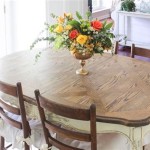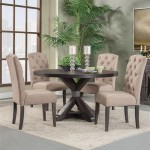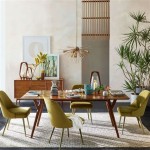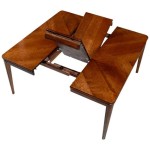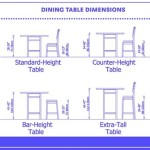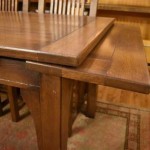The Dining Room Table With Settee: A Blend of Style and Functionality
The dining room serves as a central gathering place within the home, a space where meals are shared, conversations unfold, and memories are created. Traditionally, dining room seating has largely been relegated to individual chairs. However, a growing trend incorporates the use of a settee, also known as a bench, as part of the dining arrangement. This integration offers a unique blend of style and functionality, presenting both aesthetic and practical advantages. The dining room table with a settee configuration can be tailored to various interior design styles and spatial constraints, proving to be a versatile choice for modern homes.
Understanding the nuances of selecting and incorporating a settee into a dining area is crucial for achieving a harmonious and functional space. Factors such as the size of the dining room, the overall design aesthetic, the comfort of the settee, and the ease of access around the table all contribute to the success of this seating arrangement. Careful consideration of these elements will ensure that the dining room table with settee becomes a welcoming and stylish centerpiece of the home.
Space Optimization and Seating Capacity
One of the primary advantages of using a settee at a dining table is its efficient use of space. Unlike individual chairs, which require ample room to be pulled out and pushed back, a settee fits neatly against the wall or beneath the table when not in use. This is particularly beneficial in smaller dining rooms or breakfast nooks where maximizing space is essential. The streamlined profile of a settee allows for easier navigation around the table, reducing clutter and improving the overall flow of the room.
Furthermore, a settee can often accommodate more people than individual chairs in the same linear space. While individual chairs typically allocate a specific width per person, a settee allows for a more flexible distribution of seating. This is especially useful when hosting larger gatherings or accommodating families with varying seating needs. The bench-style seating encourages closer proximity and a more communal dining experience, fostering a sense of togetherness. When planning for seating requirements, one must consider the average width required per person (approximately 24 inches) and the overall length of the settee to accurately estimate the number of individuals it can comfortably accommodate.
The versatility of a settee also extends to its placement. It can be positioned against a wall, creating a built-in banquette feel, or it can be placed on one side of the table, offering a contrast to the individual chairs on the opposite side. In larger dining rooms, two settees can be placed on opposite sides of the table, creating a more formal and symmetrical arrangement. The choice of placement will depend on the size and shape of the room, the desired aesthetic, and the practical needs of the household.
Aesthetic Versatility and Design Integration
The addition of a settee to a dining room immediately introduces a distinct aesthetic element, offering a wide range of design possibilities. Settees are available in a variety of styles, from traditional and ornate designs to modern and minimalist forms. This versatility allows for seamless integration into various interior design schemes, whether it be a classic farmhouse, a contemporary loft, or a bohemian-inspired space. The choice of upholstery, material, and overall design of the settee can significantly impact the overall ambiance of the dining room.
For a more rustic or farmhouse aesthetic, a wooden settee with a simple, unadorned design can be paired with a distressed wooden dining table. Upholstery in natural fabrics like linen or cotton can further enhance the rustic feel. Conversely, a sleek, upholstered settee with clean lines and metal legs would be more fitting for a modern or contemporary dining room. The choice of upholstery fabric, such as leather or velvet, can add a touch of luxury and sophistication.
Furthermore, the settee can serve as a focal point in the dining room, adding visual interest and character to the space. A brightly colored or patterned settee can inject personality and vibrancy into a neutral-toned room. Conversely, a neutral-colored settee can provide a calming and grounding element in a more colorful and eclectic space. The possibilities are endless, and the choice of settee should be carefully considered to complement the existing décor and overall design vision.
The integration of cushions and throw pillows can further enhance the aesthetic appeal and comfort of the settee. These accessories can be easily changed to reflect seasonal trends or to update the look of the dining room without requiring a major overhaul. A collection of cushions in varying textures and patterns can add depth and visual interest to the settee, while a simple throw blanket can provide warmth and comfort during cooler months.
Enhancing Comfort and Functionality
While aesthetics are important, the comfort of the dining room seating is paramount. A settee should provide adequate support and cushioning to ensure a comfortable dining experience. The depth and height of the seat, as well as the angle of the backrest, should be carefully considered to promote proper posture and prevent discomfort during extended meals. Upholstery materials such as high-density foam and durable fabrics are essential for ensuring long-lasting comfort and resilience.
The functionality of the settee can be further enhanced through the addition of features such as storage compartments. Some settees are designed with built-in drawers or lift-up seats, providing a convenient storage solution for items such as placemats, napkins, or even children's toys. This is particularly useful in smaller homes where storage space is limited. The incorporation of storage features can help to declutter the dining room and create a more organized and functional space.
Furthermore, the placement of the dining table in relation to the settee is crucial for ensuring ease of access and comfortable dining. The table should be positioned close enough to the settee to allow for easy reaching, but not so close that it restricts movement. The height of the table should also be compatible with the height of the settee to ensure proper legroom and a comfortable dining posture. A general guideline is to maintain a distance of approximately 12 inches between the seat of the settee and the underside of the table. This allows ample space for legs while dining.
The material of the settee is another important consideration, especially in households with children or pets. Durable and stain-resistant fabrics are essential for withstanding spills and everyday wear and tear. Leather and microfiber are popular choices for their durability and ease of cleaning. Alternatively, slipcovers can be used to protect the settee from stains and damage, and they can be easily removed and washed as needed.
In conclusion, the dining room table with settee configuration offers a multifaceted approach to dining room design, combining space optimization, aesthetic versatility, and enhanced comfort. By carefully considering the size of the room, the design aesthetic, and the practical needs of the household, one can create a dining space that is both stylish and functional. The settee, when implemented thoughtfully, becomes more than just a seating option; it transforms into a focal point that fosters connection and elevates the overall dining experience.
The success of integrating a settee into a dining arrangement hinges on careful planning and attention to detail. From selecting the right size and style to considering comfort and functionality, each element plays a crucial role in creating a cohesive and inviting dining space. As homes continue to evolve and adapt to modern living, the dining room table with settee remains a relevant and compelling option for those seeking to maximize space, enhance aesthetics, and foster a sense of togetherness in the heart of their home.
Ultimately, the choice of incorporating a settee into a dining room is a personal one, driven by individual preferences and lifestyle. However, by understanding the benefits and considerations outlined above, homeowners can make informed decisions that result in a dining space that is both beautiful and functional, serving as a cherished gathering place for years to come. The enduring appeal of the dining room table with settee lies in its ability to adapt to diverse needs and styles, making it a timeless and versatile choice for modern homes.

Hayward 6 Piece Brown Dining Set Table 4 Tall Back Chairs And Settee Dgc500sl6pc The Home

Cozy Up To A Loveseat At The Table

Header Settees And Dining Tables Kitchen Seating Home Decor Room Table

Look Inside An Early 20th Century Shingle Style Getaway In The Hamptons Dining Room Design Kitchen Banquette Upholstered

Gray Leather Wingback Settee At Oval Trestle Table Transitional Dining Room

Living Room Meets Dining The New Way To Eat In

Franklin Dining Room Set W Upholstered Chairs And Settee Elements Furniture Cart

Bring Elegance To Your Home With Dining Banquettes Settees

Wednesday Watch List Dining Room Trends Settee Home Decor

The Best 7 Ways To Incorporate A Sofa In Dining Room

